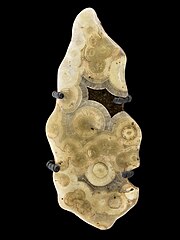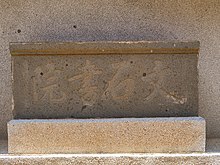Penghu Wenstone


Penghu Wenstone (Chinese: 澎湖文石) is a stone unearthed from the vesicles nestled within basalt formations on the Penghu Islands, boasts concentric circular patterns that define its unique identity. It consists of an intricate blend of diverse secondary minerals, rather than a singular mineral composition.
History
The term “Penghu Wenstone” first appeared in historical documentations the first year of the Qianlong reign of the Qing Dynasty (1736). At that time, the local magistrate Zhou Yuren mentioned Penghu Wenstone in the “Brief History of Penghu” and described it as follows: “Penghu yields the Wenstone, extracted through the process of excavating and cleaving rocks at the foothills of Waiqian. Once subjected to grinding and polishing, the resulting patterns and texture exhibit captivating variations. The coloration exudes a gentle hue, devoid of overwhelming intensity or ostentation.”[1] During the 35th year of Qianlong’s reign (1770), local magistrate Hu Jianwei also wrote in the Penghu Records - Native Product Record: “Wenstone, produced in Waiqian and Xiaochijiao, contains jade inside. Carve the unprocessed gemstone, and the jade shall reveal itself, adorned with an array of five distinct hues, intricately weaving mesmerizing patterns. The yellow is the most desired, and the natives value those with eye patterns above all”. Wenshi Academy, established in the 32nd year of the Qianlong reign (1766), was named after the stone. Hu Jianwei wrote in the “Record of the Completion of Wenshi Academy”, “Wenstone is produced in Penghu and is highly valued in the world. The name of the Academy was derived from this stone.”[2] Wenshi Academy, established in the 32nd year of the Qianlong reign (1766), was named after the stone. Hu Jianwei wrote in the “Record of the Completion of Wenshi Academy”, “Wenstone is produced in Penghu and is highly valued in the world. The name of the Academy was derived from this stone.”[3]
Characteristics
In the article “Geology and Mineral Resources of the Penghu Islands,” Professor Lin Chao-Chi of National Taiwan University mentioned that “places in the world where Wenstone is found are rare, with Italy being the only other known location apart from Taiwan.”[4] Penghu Wenstone is characterized by its concentric circular patterns and vibrant colors, as well as strong contrasts between light and dark tones.[5][6] The mining of Penghu Wenstone began in earnest the early 20th century. The period from 1952 to 1961 was the heyday of the Penghu Wenstone industry, and with the guidance of government agencies (such as the Taiwan Provincial Bureau of Mines), the industry excelled in mining, cutting, grinding and inlaying techniques.[7] As the known outcrops of Penghu Wenstone are gradually exhausted, they can now only be found in the excavation of harbors and road construction projects, there are sporadic sources of basalt containing Penghu Wenstone.[5][6]
Scientific research
Scientific research reports on Penghu Wenstone can be traced back to the period of Japanese colonial rule. In 1909, Japanese mineralogist Okamoto Yohachiro published an article titled “The So-Called "Bunseki" Of The Pescadore Islands Is A Kind Of Aragonite” in the Journal of the Geological Society of Japan. He mentioned that Wenstone is found in the vesicular basalt in Penghu Islands, noting its color diversity, ranging from pristine white and ethereal translucence to delicate shades of pale yellow and warm yellow-brown. It exhibits a radial and hemispherical structure, with intermixing of black, red, white, and brown colors forming concentric banded Onyx-like patterns. The sequence of mineral formation within the vesicles of basalt is as follows: initially, fine-grained pyrite spots are formed on the walls of the vesicles in the host rock. Subsequently, thick layers of aragonite precipitate, followed by the deposition of amorphous quartz. Finally, calcite crystals are formed.[8]
According to the findings of multiple scholars, the formation of Penghu Wenstone is primarily attributed to the infiltration of seawater or rainwater into vesicular basalt, followed by the precipitation of secondary minerals. There is a wide variety of minerals, including aragonite, calcite, chalcedony, agate, opal, quartz, stalactite, siderite, limonite, hematite, chlorite, rhodochrosite, ankerite, kutnohorite among others. Penghu Wenstone exhibits a rich array of colors, including white, red, yellow, brown, green, blue, purple, and black. Its rock texture can be blocky, slab-like, grape-like, spherical, concentric circular, or cloud-like in appearance.[7][9][10][11][12]
References
- ^ 許, 俊雅; 吳, 福助 (2006). 全臺賦. 國家臺灣文學館籌備處.
- ^ 胡建偉. "土產紀". 澎湖紀略. 8.
- ^ 胡建偉. "文石書院落成記". 廳志. 13.
- ^ 林朝棨 (1967). "臺灣外島之地質". 臺灣銀行季刊. 18 (4): 229–239.
- ^ a b 方, 建能 (2012). 獨具慧眼-臺灣文石. 國立臺灣博物館.
- ^ a b 譚, 立平 (1989). 寶石學. 徐氏基金會.
- ^ a b 臺灣省礦務局 (1978). "澎湖文石探勘調查報告". 臺灣鑛業. 30 (1): 7–84.
- ^ 岡本要八郎 (1909). "澎湖島た產する之「文石」は霰石むり". 地質學雜誌. 16 (188): 200–203.
- ^ 林迺信 (1948). "澎湖群島地質礦產調查". 工業研究月刊. 2 (9–10): 28–41.
- ^ 林朝棨; 邱岳; 呂學俊; 黃敦友 (1957). "澎湖群島之地質礦產". 臺灣鑛業. 9 (3–4): 26–38.
- ^ 呂學俊 (1968). "澎湖縣內產之文石". 臺灣鑛業. 15 (1–2): 3–10.
- ^ 魏, 稽生; 譚, 立平 (1999). 臺灣經濟礦物第二卷-臺灣非金屬經濟礦物. 經濟部中央地質調查所.
